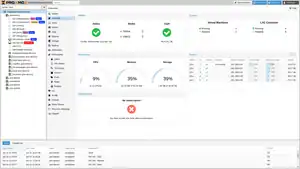Proxmox Virtual Environment
Proxmox Virtual Environment (Proxmox VE or PVE) is a hyper-converged infrastructure open-source software. It is a hosted hypervisor that can run operating systems including Linux and Windows on x64 hardware. It is a Debian-based Linux distribution with a modified Ubuntu LTS kernel[7] and allows deployment and management of virtual machines and containers.[8][9] Two types of virtualization are supported: container-based with LXC (starting from version 4.0 replacing OpenVZ used in version up to 3.4, included[10]), and full virtualization with KVM.[11] It includes a web-based management interface.[12][13]
 Proxmox VE 8.0 administration interface screenshot | |
| Developer | Proxmox Server Solutions GmbH |
|---|---|
| Written in | Perl,[1] Rust[2] |
| OS family | Linux (Unix-like) |
| Working state | Current |
| Source model | Free and open source software |
| Initial release | 15 April 2008 |
| Latest release | 8.0[3] |
| Latest preview | 8.0 beta1[4] / 9 June 2023 |
| Repository | |
| Available in | 25 languages[5] |
| Update method | APT |
| Package manager | dpkg |
| Platforms | AMD64 |
| Kernel type | Monolithic (Linux) |
| Userland | GNU |
| Default user interface | Web-based |
| License | Affero General Public License[6] |
| Official website | www |
History
Development of Proxmox VE started when Dietmar Maurer and Martin Maurer, two Linux developers, found out OpenVZ had no backup tool and no management GUI. KVM was appearing at the same time in Linux, and was added shortly afterwards.[14]
The first public release took place in April 2008. It supported container and full virtualization, managed with a web-based user interface similar to other commercial offerings.[15]
Features
Proxmox VE is an open-source server virtualization platform to manage two virtualization technologies: Kernel-based Virtual Machine (KVM) for virtual machines and LXC for containers - with a single web-based interface.[11] It also integrates out-of-the-box-tools for configuring high availability between servers, software-defined storage, networking, and disaster recovery.[16]
High-availability cluster
Proxmox VE (PVE) can be clustered across multiple server nodes.[17]
Since version 2.0, Proxmox VE offers a high availability option for clusters based on the Corosync communication stack. Starting from the PVE v.6.0 Corosync v.3.x is in use (not compatible with the earlier PVE versions). Individual virtual servers can be configured for high availability, using the built-in ha-manager.[18][19] If a Proxmox node becomes unavailable or fails, the virtual servers can be automatically moved to another node and restarted.[20] The database and FUSE-based Proxmox Cluster filesystem (pmxcfs[21]) makes it possible to perform the configuration of each cluster node via the Corosync communication stack with SQLite engine.[13]
Virtual appliances
Proxmox VE has pre-packaged server software appliances which can be downloaded[22] via the GUI.
See also
References
- "Proxmox Manager Git Tree". Retrieved 4 March 2019.
- "Proxmox VE Rust Git Tree". git.proxmox.com.
- "Proxmox VE 8.0 released!". 22 June 2023. Retrieved 22 June 2023.
- "Roadmap". Proxmox. Retrieved 2014-12-03.
- "projects / proxmox-i18n.git / tree". Retrieved 16 November 2022.
- "Open Source – Proxmox VE". Proxmox Server Solutions. Retrieved 17 July 2015.
- "Proxmox VE Kernel - Proxmox VE". pve.proxmox.com. Retrieved 2017-05-26.
- Simon M.C. Cheng (31 October 2014). Proxmox High Availability. Packt Publishing Ltd. pp. 41–. ISBN 978-1-78398-089-5.
- Plura, Michael (July 2013). "Aus dem Nähkästchen". IX Magazin. Heise Zeitschriften Verlag. 2013 (7): 74–77. Retrieved July 20, 2015.
- "Proxmox VE 4.0 with Linux Containers (LXC) and new HA Manager released". Proxmox. 11 December 2015. Retrieved 12 December 2015.
- Ken Hess (July 11, 2011). "Proxmox: The Ultimate Hypervisor". ZDNet. Retrieved September 29, 2021.
- Vervloesem, Koen. "Proxmox VE 2.0 review – A virtualisation server for any situation", Linux User & Developer, 11 April 2012. Retrieved on 16 July 2015.
- Drilling, Thomas (May 2013). "Virtualization Control Room". Linux Pro Magazine. Linux New Media USA. Retrieved July 17, 2015.
- "Proxmox VE 1.5: combining KVM and OpenVZ". Linux Weekly News. Retrieved 2015-04-10.
- Ken Hess (April 15, 2013). "Happy 5th birthday, Proxmox". ZDNet. Retrieved October 4, 2021.
- "Features". www.proxmox.com. Retrieved 2019-05-12.
- Wasim Ahmedi (2014-07-14). Mastering Proxmox. Packt Publishing Ltd. pp. 99–. ISBN 978-1-78398-083-3.
- "PVE HA Manager Source repository". Retrieved 2020-10-19.
- "Proxmox VE documentation: High Availability". Retrieved 2020-10-19.
- "High Availability Virtualization using Proxmox VE and Ceph". Jacksonville Linux Users' Group. Archived from the original on 2020-11-30. Retrieved 2017-12-15.
- "Proxmox Cluster File System (pmxcfs)". Proxmox VE Administration Guide. Retrieved 15 November 2022.
- "The next server operating system you buy will be a virtual machine". ZDNET. 15 October 2013. Retrieved 20 July 2015.